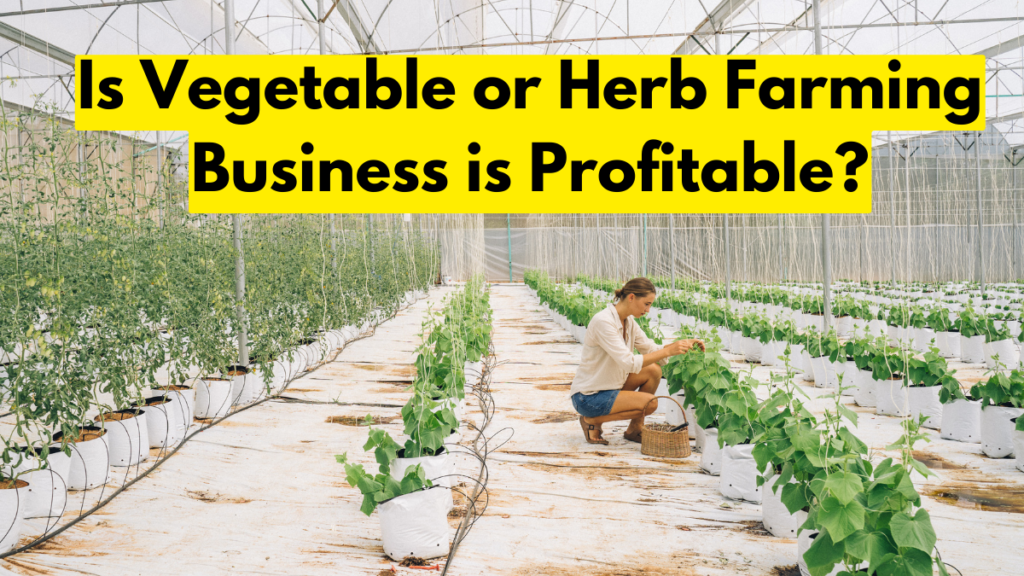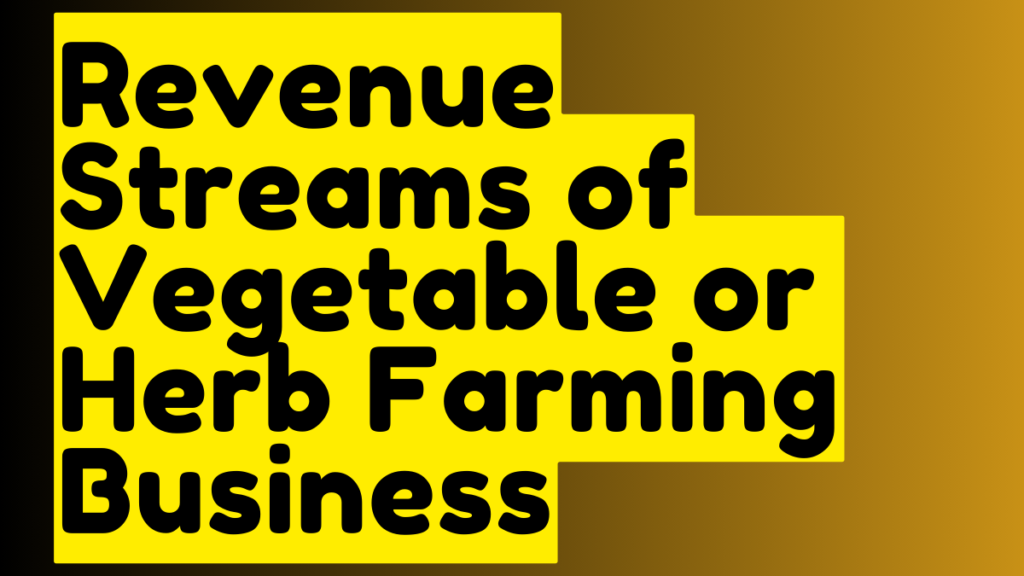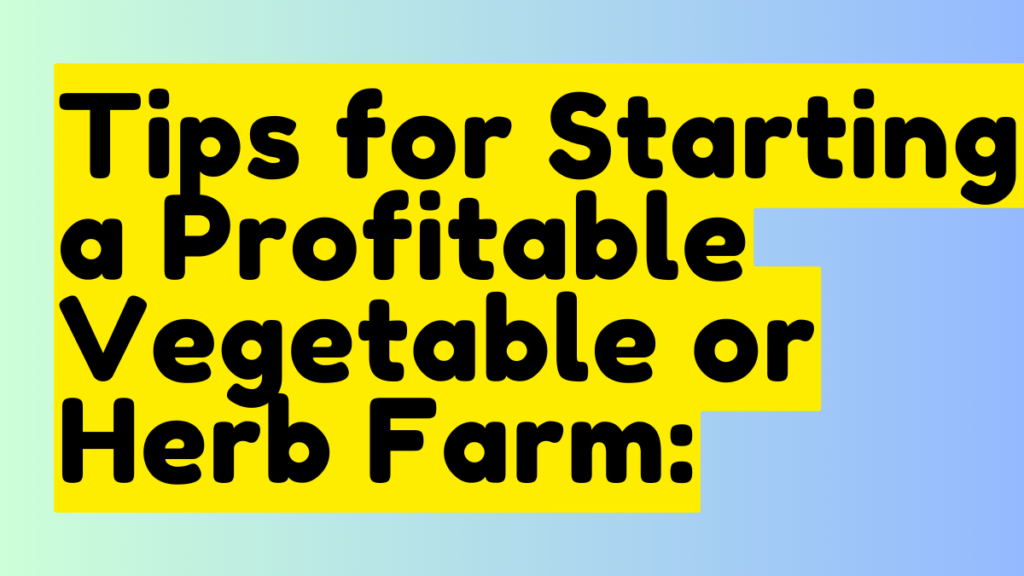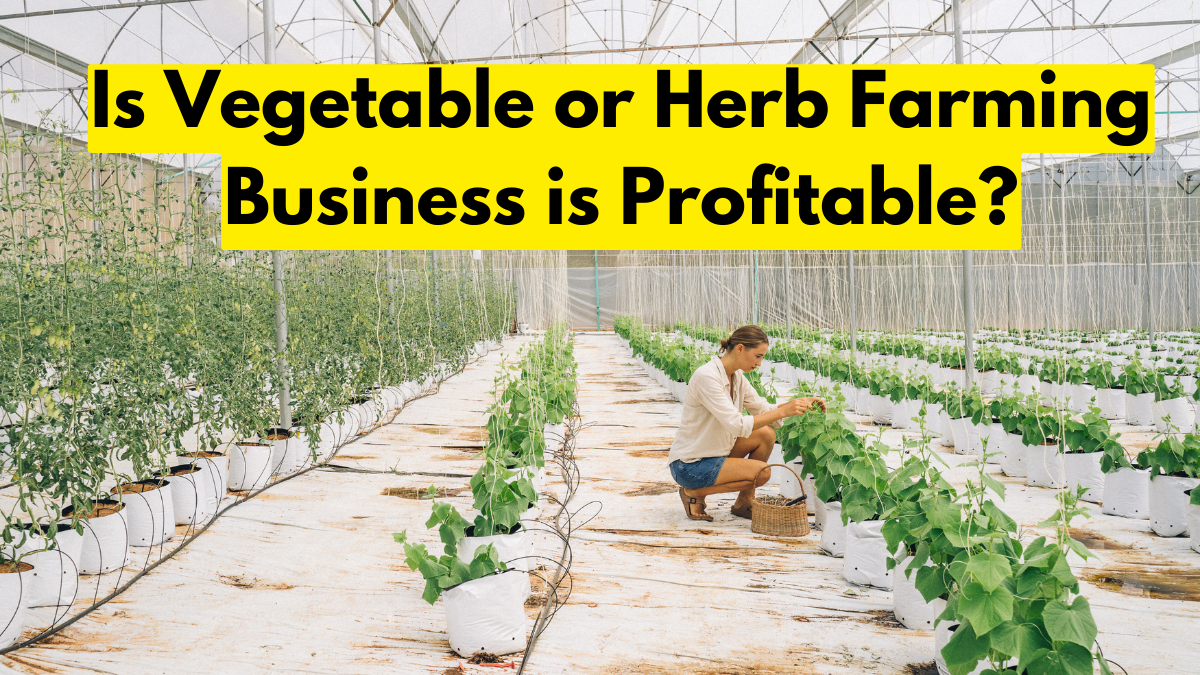Understanding the Vegetable and Herb Farming Industry :
Vegetable and herb farming is not just a traditional occupation; it’s a thriving business with the potential for significant profitability. As the world grapples with issues such as food security, sustainability, and a growing interest in healthy eating, the demand for fresh, locally grown vegetables and herbs is on the rise. This article explores the profitability of vegetable and herb farming, considering various factors that influence success in this industry.
Agriculture has been the backbone of human civilization, providing sustenance and livelihoods for centuries. In the modern context, vegetable and herb farming contribute substantially to the global food supply chain, offering nutritional diversity and economic opportunities.

Consumer preferences are evolving, with an increasing focus on health and sustainability. This shift has led to a surge in demand for fresh, organic, and locally sourced produce, creating a favorable market for vegetable and herb farmers. Market and Demand for Medicinal Plants/Herbs Farming. The market for medicinal plants was worth Rs. 4.2 billion (US$ 56.6 million) in 2019 is expected to grow at a CAGR of 38.5% to reach Rs. 14 billion (US$ 188.6 million) approx. by 2026.
Factors Influencing Profitability of Vegetable or Herb Farming Business:
· Location and Climate
The choice of location plays a crucial role in the success of a vegetable or herb farm. Factors such as climate, soil quality, and proximity to markets determine the types of crops that can be grown and the overall yield.
· Crop Selection
Selecting the right crops is a key decision for farmers. Understanding market demand, seasonal variations, and crop compatibility are essential factors in maximizing profitability.
· Sustainable Practices
Adopting sustainable farming practices not only aligns with consumer preferences but also reduces long-term costs. Practices such as organic farming, crop rotation, and water conservation contribute to both environmental and economic sustainability.
Costs and Investments for Vegetable or Herb Farming Business:
· Land and Infrastructure
Acquiring suitable land and developing necessary infrastructure are initial investments that significantly impact the overall cost of starting a farming business. Efficient land use planning can optimize productivity and reduce costs.
· Seeds and Planting Materials
Investing in high-quality seeds and planting materials is essential for a successful harvest. Farmers need to balance cost considerations with the potential yield and market value of the chosen crops.
· Labor
Labor costs constitute a significant portion of the expenses in farming. Efficient management and utilization of labor resources are crucial for maintaining profitability.
· Equipment and Technology
Modern farming often involves the use of advanced equipment and technology. While initial investments may be high, the long-term benefits in terms of efficiency and yield can outweigh the costs.

Revenue Streams of Vegetable or Herb Farming Business:
· Direct Sales:
Selling directly to consumers through farmers’ markets, community-supported agriculture (CSA), or on-farm stands allows farmers to capture a larger share of the retail price, maximizing profits.
· Wholesale Distribution:
Entering into wholesale agreements with supermarkets, restaurants, and grocery stores provides a broader market reach. However, it requires efficient supply chain management and adherence to quality standards.
· Value-Added Products:
Processing and packaging vegetables and herbs into value-added products, such as sauces, dried herbs, or pickles, can open up new revenue streams and enhance overall profitability.
Market Analysis for Vegetable or Herb Farming Business:
· Identifying Target Markets:
Understanding the demographics and preferences of target markets is crucial. Tailoring crop selection and marketing strategies to meet consumer demands can lead to higher sales.
· Consumer Preferences:
Consumers are increasingly seeking transparency and traceability in their food sources. Emphasizing factors such as organic, locally sourced, and sustainably grown produce can be a competitive advantage.
· Market Trends:
Staying abreast of market trends, such as the rise of plant-based diets or the demand for exotic herbs, allows farmers to capitalize on emerging opportunities.
Challenges in Vegetable and Herb Farming:
· Pests and Diseases:
Crop diseases and pest infestations pose significant challenges. Implementing integrated pest management (IPM) strategies and investing in disease-resistant varieties can mitigate these risks.
· Weather Risks:
Unpredictable weather patterns can impact crop yields. Farmers may need to invest in protective measures, such as greenhouses or irrigation systems, to mitigate the effects of adverse weather.
· Market Competition:
The agricultural sector can be highly competitive. Establishing a unique selling proposition (USP) and building strong relationships with buyers can help farmers stand out in the market.
· Regulatory Compliance:
Compliance with agricultural regulations, quality standards, and certifications is essential. Failure to meet these requirements can lead to legal issues and damage the reputation of the farm.
Pros and Cons of Vegetable and Herb Farming Business:
| Pros | Cons |
| 1. Growing Demand: Increasing demand for fresh, local produce. | 1. Market Risks: Vulnerable to market fluctuations and changing consumer preferences. |
| 2. Health Trends: Rise in consumer focus on healthy, organic foods. | 2. Weather Dependency: Susceptible to adverse weather conditions impacting crop yields. |
| 3. Profitable Niche Markets: Opportunities in niche markets, such as organic or specialty herbs. | 3. High Initial Investments: Substantial upfront costs for land, infrastructure, and equipment. |
| 4. Direct Sales Advantage: Potential for higher profits through direct sales to consumers. | 4. Pest and Disease Risks: Constant threat of pests and diseases affecting crops. |
| 5. Value-Added Products: Ability to diversify income through processed or packaged products. | 5. Labor-Intensive: Labor costs can be high, especially during planting and harvesting seasons. |
| 6. Sustainable Practices: Growing demand for sustainably produced vegetables and herbs. | 6. Time-Consuming: Farming requires substantial time and effort, often with seasonal variations. |
| 7. Local Economic Impact: Contributes to local economies and community development. | 7. Market Competition: Intense competition within the agricultural sector. |
| 8. Technology Advancements: Adoption of technology for improved efficiency and productivity. | 8. Regulatory Compliance: Need to comply with regulations, certifications, and quality standards. |
| 9. Diversification Opportunities: Options to diversify crops and explore new varieties. | 9. Land Availability: Limited availability of suitable land for farming. |
| 10. Global Market Opportunities: Access to global markets for export potential. | 10. Post-Harvest Handling: Challenges in proper storage and transportation of perishable produce. |
| 11. Consumer Education: Growing awareness leading to educated and discerning consumers. | 11. Water Management: Efficient water management is crucial, posing challenges in water-scarce regions. |
| 12. Flexibility in Scaling: Scalability options based on market demands and success. | 12. Market Volatility: Prices can be volatile due to various factors. |
| 13. Community Engagement: Opportunities for community-supported agriculture (CSA) models. | 13. Globalization Risks: Vulnerable to global economic shifts and trade policies. |
| 14. Job Creation: Contribution to employment opportunities, especially in rural areas. | 14. Learning Curve: Steep learning curve for new farmers entering the industry. |
| 15. Potential for Innovation: Room for innovation and adopting emerging farming technologies. | 15. Dependency on Middlemen: Reliance on intermediaries can impact profit margins. |
Sustainability and Organic Farming :
· Growing Demand for Organic Produce:
The increasing consumer preference for organic products presents opportunities for farmers willing to adopt organic farming practices.
· Certification and Practices:
Navigating the process of obtaining organic certifications and implementing sustainable farming practices to meet the rising demand for environmentally friendly produce.

Tips for Starting a Profitable Vegetable or Herb Farm:
| No. | Tips for Starting a Profitable Vegetable or Herb Farm |
| 1. | Conduct Feasibility Studies: Before starting, thoroughly research market conditions, potential challenges, and opportunities to make informed decisions. |
| 2. | Build a Strong Network: Establish connections with local markets, distributors, and fellow farmers for valuable insights and support. |
| 3. | Leverage Technology: Explore advancements in precision agriculture, automation, and data analytics to enhance efficiency and productivity. |
| 4. | Diversify Crops: Mitigate risks by growing a variety of crops suited to your region and market demands. |
| 5. | Understand Local Climate: Tailor your crop selection to the local climate, ensuring optimal growth and yield. |
| 6. | Invest in Quality Seeds: Choose high-quality seeds and planting materials to maximize the potential for a successful harvest. |
| 7. | Optimize Land Use: Plan the layout of your farm efficiently to make the most of available space and resources. |
| 8. | Implement Sustainable Practices: Adopt eco-friendly farming methods to align with consumer preferences and reduce long-term costs. |
| 9. | Explore Value-Added Products: Consider processing and packaging options to create additional revenue streams. |
| 10. | Manage Labor Efficiently: Effectively organize and utilize labor resources to control costs and improve overall productivity. |
| 11. | Know Your Market: Understand the demographics and preferences of your target market to tailor your products and marketing strategies. |
| 12. | Consider Direct Sales: Selling directly to consumers through farmers’ markets or on-farm stands can maximize profits. |
| 13. | Adapt to Market Trends: Stay informed about market trends, such as the rise of plant-based diets, and adjust your offerings accordingly. |
| 14. | Prioritize Regulatory Compliance: Ensure compliance with agricultural regulations, quality standards, and certifications to build trust with consumers. |
| 15. | Be Resilient: Expect challenges and setbacks; resilience and adaptability are crucial for long-term success in farming. |
· Conducting Feasibility Studies:
Thoroughly researching and analyzing market conditions, potential challenges, and opportunities before embarking on a farming venture.
· Building a Strong Network:
Establishing connections with local markets, distributors, and other farmers can provide valuable insights and support.
· Leveraging Technology:
Exploring the latest technological advancements in farming, including precision agriculture, automation, and data analytics, to enhance efficiency.
· Diversification Strategies:
Diversifying crops, revenue streams, and market channels can help mitigate risks and adapt to changing market conditions.
Future Outlook of Vegetable and Herb Farming:
Emerging technologies like vertical farming and blockchain in agriculture are expected to play pivotal roles, revolutionizing traditional farming methods and enhancing efficiency. As the industry adapts to meet changing consumer preferences, particularly with the rising popularity of plant-based diets and a focus on sustainable consumption, farmers must anticipate these shifts to remain competitive. Additionally, global market dynamics, influenced by factors such as trade policies, climate change, and economic shifts, will impact the profitability and viability of vegetable and herb farming on a broader scale. Navigating these future trends will be essential for farmers seeking sustained success, emphasizing the need for agility, innovation, and a forward-thinking approach in this dynamic and evolving agricultural landscape.
Frequently Asked Questions related to Vegetable and Herb Farming Business:
| FAQs | Answers |
| 1. Is vegetable or herb farming a profitable business? | Yes, vegetable and herb farming can be highly profitable, especially with the increasing demand for fresh, locally grown produce and the emphasis on healthy, organic options. |
| 2. What factors influence the profitability of farming? | Factors such as location, climate, crop selection, sustainable practices, and effective cost management play a significant role in determining the profitability of vegetable and herb farming. |
| 3. How does location impact the profitability of a farm? | The choice of location affects the types of crops that can be grown, market accessibility, and overall yield. A suitable location with favorable climate conditions can contribute to higher profitability. |
| 4. What are the main costs and investments in farming? | Key investments include land and infrastructure, seeds, labor, and equipment. Each aspect requires careful consideration to optimize costs and ensure a sustainable and profitable farming operation. |
| 5. Is there a risk of pests and diseases in vegetable farming? | Yes, pests and diseases pose a significant risk to crops. Implementing integrated pest management (IPM) strategies and investing in disease-resistant varieties are essential for mitigating these risks. |
| 6. How does weather impact the profitability of farming? | Unpredictable weather patterns can impact crop yields. Farmers may need to invest in protective measures, such as greenhouses or irrigation systems, to mitigate the effects of adverse weather conditions. |
| 7. Can small-scale farmers compete in the market? | Yes, small-scale farmers can compete by focusing on niche markets, adopting sustainable practices, and building strong local connections. Finding unique selling points and offering quality products can give them a competitive edge. |
| 8. Is there a demand for organic produce in the market? | Yes, there is a growing demand for organic vegetables and herbs. Consumers are increasingly seeking transparent and traceable food sources, making organic farming a profitable venture for those willing to meet this demand. |
| 9. How can technology enhance profitability in farming? | Technology, such as precision agriculture, automation, and data analytics, can improve efficiency, reduce costs, and enhance overall productivity. Farmers can leverage these advancements to stay competitive in the modern agricultural landscape. |
| 10. What are some tips for starting a profitable farm? | Tips include conducting feasibility studies, building a strong network, leveraging technology, diversifying crops, and understanding market trends. These strategies can contribute to the overall success and profitability of a vegetable or herb farm. |
| 11. Is direct sales a viable option for farmers? | Yes, direct sales through farmers’ markets, community-supported agriculture (CSA), or on-farm stands can provide farmers with a higher share of the retail price, contributing to increased profitability. |
| 12. Are there challenges in obtaining organic certifications? | While obtaining organic certifications can be challenging, it is essential for meeting the growing demand for organic produce. Farmers need to adhere to specific practices and undergo rigorous evaluations to achieve and maintain these certifications. |
| 13. How do farmers deal with market competition? | Farmers can stand out by establishing a unique selling proposition (USP), building strong relationships with buyers, and continuously adapting to changing consumer preferences. A focus on quality and innovation can help mitigate the challenges of market competition. |
| 14. What is the role of community-supported agriculture (CSA)? | CSA models involve consumers directly supporting local farms by subscribing to receive regular shipments of fresh produce. This approach fosters community engagement, provides a steady income for farmers, and contributes to the overall profitability of the farm. |
| 15. Is water management crucial in vegetable farming? | Yes, efficient water management is crucial for sustainable farming. Farmers need to implement irrigation systems and conservation practices to optimize water use, especially in regions where water scarcity is a concern. |
| 16. How can farmers adapt to changing consumer preferences? | Staying informed about market trends, consumer preferences, and emerging diets, such as plant-based or sustainable eating, allows farmers to adapt their crop selection and marketing strategies to meet evolving demands. |
| 17. Can vegetable farming contribute to global markets? | Yes, farmers can access global markets for export potential. Understanding global market dynamics and adhering to international quality standards is essential for successfully participating in the global agricultural trade. |
| 18. Are there risks associated with market volatility? | Yes, prices in the agricultural sector can be volatile due to factors such as weather events, economic shifts, and trade policies. Farmers need to be aware of these risks and implement strategies to manage price fluctuations effectively. |
| 19. How can technology advancements shape the future of farming? | Emerging technologies like vertical farming, blockchain in agriculture, and advanced analytics are likely to revolutionize farming. Farmers embracing these innovations can enhance efficiency, reduce costs, and stay competitive in the evolving agricultural landscape. |
| 20. Is there support for new farmers entering the industry? | Yes, various agricultural extension services, government programs, and farming communities provide support and resources for new farmers. Accessing these resources can help beginners navigate the challenges and build a successful farming business. |
| 21. Can vegetable farming contribute to employment opportunities? | Yes, vegetable farming can contribute to job creation, particularly in rural areas. As farms grow, there is an increased need for labor in various stages of the farming process, offering employment opportunities and supporting local economies. |
| 22. How do farmers manage the learning curve in agriculture? | New farmers can manage the learning curve by seeking guidance from experienced farmers, participating in agricultural training programs, and staying informed about the latest farming practices. Continuous learning is crucial for success in the dynamic field of agriculture. |
| 23. What is the role of community engagement in farming? | Community engagement, such as participating in local events, farmers’ markets, and educational programs, not only promotes the farm but also strengthens community ties. Building a supportive community can contribute to the overall success and profitability of the farm. |
| 24. Is there a risk of dependency on middlemen in farming? | Yes, reliance on intermediaries can impact profit margins. Farmers should explore direct sales options and build relationships with buyers to reduce dependency on middlemen, ensuring a more direct and profitable connection with consumers. |
| 25. How can farmers ensure a resilient and adaptable approach? | Expecting challenges and setbacks is essential. Farmers can enhance resilience by diversifying crops, revenue streams, and market channels, staying informed about industry trends, and adopting an adaptable mindset to navigate changes and uncertainties effectively. |
Conclusion:
In summary, the profitability of vegetable and herb farming hinges on strategic planning, sustainable practices, and market adaptability. Despite challenges, success stories demonstrate the viability of this endeavor. By making informed decisions, investing in technology, and prioritizing sustainability, newcomers can cultivate both crops and a rewarding livelihood.
Vegetable and herb farming profitability is influenced by diverse factors. Rising demand for fresh, organic produce and health-conscious trends offer ample opportunities. Yet, market risks, weather fluctuations, and initial investments pose hurdles. Sustainable practices, technological integration, and strategic positioning are pivotal for success.
Direct sales, CSA models, and networking are essential. Farmers must navigate regulations, combat pests, and stay attuned to global markets. Innovation and resilience underline the sector’s potential.
Amidst agricultural evolution, emerging technologies and sustainability drive future prospects. Profitable farming necessitates informed decisions, quality commitment, and meeting discerning market demands.
Disclaimer:
The information provided is for general informational purposes only and should not be considered as professional advice; readers are encouraged to seek appropriate professional guidance for their specific circumstances.
